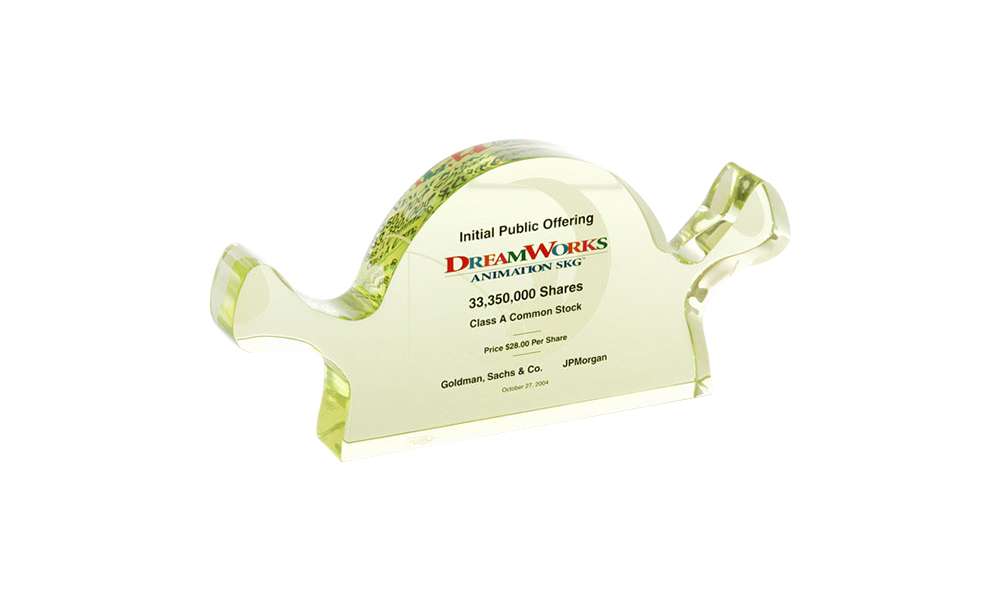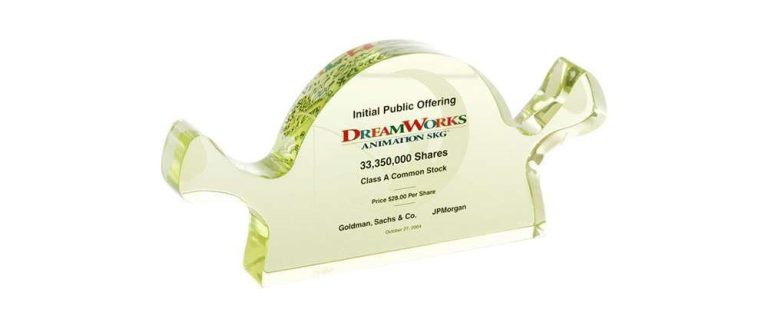The DreamWorks IPO Deal Toy: The Duel Behind The “Shrek” Design

The DreamWorks IPO deal toy design shouldn’t have been too surprising. Even now, almost 20 years later, the Shrek-inspired, translucent green design may still seem like an obvious, almost inevitable choice.
But it was also a design choice that illustrates an essential part of the enduring appeal of deal toys themselves.
You may have heard deal toys disparaged as “tchotchkes” or “trinkets”: silly, self-indulgent, frivolous, and ultimately pointless knick-knacks having little or no intrinsic value.
That’s often not the case, though, when it comes to their recipients. For them, the perceived value can be extremely high.
We often talk about deal toys having special “resonance” for their recipients. Their designs often reflect some aspect of the deal or the subject company that has special, even unique meaning for the deal’s participants.
The Shrek-inspired design undoubtedly provided plenty in the way of additional resonance for one of the key players in the DreamWorks IPO.
“That little green ogre”, Jeffrey Katzenberg once explained, “saved us”.
He would know.
Released in 2001, “Shrek” was the first unqualified hit for the new studio’s triumvirate, composed of Katzenberg, Steven Spielberg and David Geffen.
It also marked its first foray into full-on computer-generated animation, a significant departure from the labor-intensive, hand-drawn process still prevailing at the time.
But for Katzenberg, the tombstone design had to have symbolized a lot more. It commemorated the studio’s signature box-office triumph. it also hinted at something a lot more personal.
Katzenberg was determined to make DreamWorks a success.
But he also had a score to settle.
The Beef Behind the DreamWorks IPO Deal Toy Design
DreamWorks teamed Jeffrey Katzenberg with two unassailable members of the Hollywood pantheon.
But Jeffrey Katzenberg hadn’t quite been on the same professional, and especially financial, footing as either Spielberg or Geffen. Unlike his two better-heeled partners, Katzenberg had been forced to make sacrifices to afford his stake in DreamWorks.
Though even this particular trip to the pawn shop had had an unmistakable Hollywood mogul touch: Katzenberg had had to mortgage his mansion in Beverly Hills.
And his Malibu beach house.
And his ski chalet in Park City, Utah.
That said, Katzenberg was certainly no slouch. His resume was undeniably impressive. He’d dropped out of NYU, worked briefly as an assistant for the mayor of New York and then launched his career in entertainment—beginning in the Paramount Pictures mailroom.
In 1984, he joined Disney, where he revitalized the studio’s moribund animation division. Among other offerings, he was responsible for hits such as The Little Mermaid, Aladdin, The Lion King, and Beauty and the Beast.
By the time of the 1994 death of Disney president Frank Wells in a helicopter crash, Katzenberg was convinced that his former mentor, chairman Michael Eisner, would tap him as the logical successor.
But in what he must’ve seen as a Logan Roy turn, Eisner passed him over.
The resulting rift between Katzenberg and Eisner was deep-seated and nasty. It was also expensive. It ultimately led to a lawsuit by Katzenberg that by some estimates cost Disney nearly $270 million—legal fees aside.
The DreamWorks IPO
The IPO specifically involved DreamWorks Animation, a unit of the parent DreamWorks SKG.
Though Katzenberg had by far the most at stake financially, the company’s first years had to be trying ones for all of its founders.
As filings for the offering showed, in the five years prior, the company had been profitable only in two. In 2002, losses had been $25.1 million. In 2003, they totaled $189 million.
The 2004 offering had come in the wake of several animated hits: Shrek 2 and Shark Tale.
But the movie grosses reported at the time only confirmed the critical importance of Shrek. DreamWorks had endured some high-profile flops. These included Sinbad: Legend of the Seven Seas, The Road to El Dorado, and Spirit: Stallion of the Cimarron. Before Shrek, its most successful animated feature, Chicken Run, took in $107 million.
By the time the IPO filing was made in July, 2004, the total U.S. box office for Shrek was $268 million. By that time, the same number for Shrek 2 had reached $425 million.
So much for Katzenberg’s little green ogre.
The Underlying Significance of the “Shrek” Design
So where’s the added “resonance” here? Is there something even more significant in the design—something beyond even Shrek’s vital role in enabling the company to mount an IPO in the first place?
Katzenberg hadn’t forgotten his grudge against Disney and Eisner.
He often sought ways to tweak his former employer, such as poaching its prized animators, or racing to bring Antz to theaters ahead of his rival’s lookalike offering A Bug’s Life (and, in the process, antagonizing Pixar and Steve Jobs as well).
Shrek had provided another opportunity for revenge.
It was reported at the time that, under explicit instructions from Katzenberg, the film’s animators modeled the villainous, prissy Lord Farquaad on a fellow member of the Hollywood community: Michael Eisner.
Contact Us For a Quote Today
"*" indicates required fields
